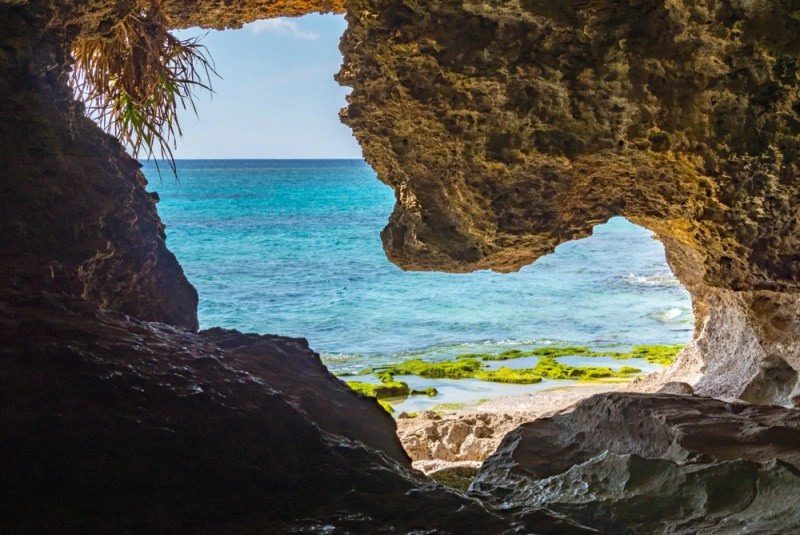
Iejima (Ieshima) is a faraway island covering a trifling 23 square kilometres. It is positioned off the northeast coast of Okinawa Island and is accessible via a 30-minute boat ride. The island features predominantly flat farmland, with Mount Iejima growing at 172 meters above sea level in the centre, imparting commanding views.
Surrounded by the sea in all its aspects, Iejima offers opportunities for scuba diving, water sports, tenting, golf, and other leisure facilities. Additionally, you may discover historical sites and warfare-related landmarks here. Why don't you go to Iejima for your trip to Okinawa?
Map of Iejima

| Name | Iejima (Japanese: 伊江島) |
| Country | Japan |
| Prefecture | Okinawa |
| Coordinates | 26°42′58″N 127°47′25″E |
| Area | 23 km2 (8.9 sq mi) |
| Time zone | UTC +9 |
| Population | 4,534 |
| Airport | Iejima Airport (IEJ) |
Getting to and Around Iejima
It takes about 30 minutes by ferry to reach Iejima Port from Motobu Port on Okinawa Island. Click here for more details.
The roads on Iejima are flat and not heavily trafficked, making exploring the island by bicycle highly recommended. Bicycle rental shops are available near the ferry terminal. Alternatively, you can rent a car on Okinawa Island and bring it over on the ferry to Iejima or on the island upon arrival.
Best Attactions on Iejima
1. Ie Beach (伊江ビーチ)

Iejima Beach is located on the eastern side of Iejima Island and boasts a beautiful 1-kilometer stretch of pristine white sand. In addition to swimming in the sea, visitors can indulge in activities such as scuba diving and jet skiing. Nearby are shops and shower facilities for added convenience during your exploration.
2. Lily Field Park (リリーフィールド公園)

"Lily Field Park" is located on the north coast, covering approximately 26,000 tsubo (86,000 square meters). During the peak season, in April, the Iejima Lily Festival is held here—around 1.2 million lilies bloom, including nearby types and diverse lilies from around the arena.
Nearby, you can visit the culturally exact Hada flowers network and the Davara Cave. This place is also renowned on Iejima Island for fishing, where you can catch Indian mackerel, Steelhead parrots, and double-lined fusilier. Additionally, you can experience cycling and horseback riding for entertainment right here.
3. Niya-Thiya Cave (ニャティヤ洞)

It is a significant sacred site for the locals of Iejima Island, with a place for prayers behind the cave, believed to be where the Inugami (dog deity) descends. It gained fame for serving as an air-raid shelter during the Battle of Okinawa, protecting many residents. Due to its large size, it is also known as "Sennen Cave(千人洞)"
4. Wajee Viewpoint (湧出展望台)

It is a point of view alongside the rugged coastline of the northern sea. Enjoy the panoramic view of the cliffs stretching out without end. The term "waji" means "spring water," and it is named for the notable water surging from the waves of the cliff. This is a spiritual power spot in which you can feel the natural energies, including the sound of the waves.
At the edge of the cliff, the spring water and seawater are crystal clear, allowing one even to look at the situations of the seabed and the coral reefs unfold out below the sea. It is a place that is mysterious to behold and profoundly refreshing to the spirit.
5. Iejima Tatchu (城山 伊江島タッチュー)

Castle Mountain, situated at the heart of Ie Island, is known as "Tacchu" inside the Ryukyu dialect. Tacchu means "rising vertically" or "pointed," a nickname for humans outside the island. You can reach halfway up by car or bicycle, with stores.
Although the street is relatively narrow and steep, the mountain route is maintained correctly with cement, ensuring a safe ascent. It takes approximately 15 minutes to attain the summit, where you can experience an astounding 360-degree panoramic view of Ie Island.
6. Local Specialties


Ie Island is predominantly cultivated with fields and farmland, focusing on peanut cultivation and cattle farming as its foremost industries. Peanuts are often exported but are extensively utilized to make tender and elastic peanut sweets referred to as "peanut tofu." Additionally, visiting the island might be incomplete without attempting Ie pork, renowned for its quality that rivals other areas' Wagyu.
Sugarcane is every other enormous product on the island, with most being delicately turned into black sugar. However, a portion is likewise used to provide the island's distinctive rum called "Ie Rum Santa Maria," available in three flavours: Gold, Crystal, and Supreme. "Gold is aged in very well barrels, Crystal in steel barrels, and Supreme is a white rum with a higher alcohol content than Gold and Crystal.
Ie Soda is a domestically produced non-alcoholic sparkling water in four flavours: Black Sugarcane Cola, White Soda, Pink Dragon, and "Green Marsu." It is flavoured with Okinawan lemongrass and salt (Marsu, which means salt in the Okinawan dialect). The Black Sugarcane Cola, which mixes spring water from Ie Island with sugarcane, is especially famous.
Climate of Iejima
Iejima is closer to the equator than Okinawa and consequently falls inside the subtropical climate zone. Consequently, the common temperature throughout the year is fairly warm. Fortunately, this is also how one best wishes to experience two wonderful seasons: the dry and rainy seasons.
The dry season generally spans from October to April, while the wet season lasts from May to September. Although the wet season may not be mainly favourable, with a high chance of showers and rainfall, at least it no longer entails torrential downpours each day!





